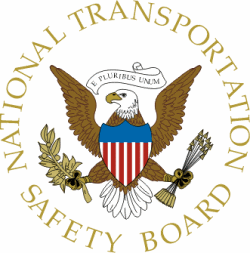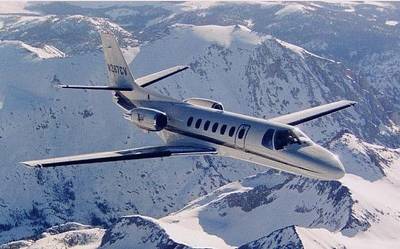Accident In NC In 2009 Caused Substantial Damage To The
Airplane, No Injuries
Fuel management is one of the principal tenets of learning to
fly. And whether it's a J-3 Cub or, as in this case a Cessna 550,
it just won't go if there's nothing in the tanks to burn. In this
incident, the NTSB found that the pilot did not do his due
diligence to be sure there was enough fuel to get to his
destination with adequate reserves. Outside of that, crew
qualifications appeared to be somewhat questionable, to boot.

NTSB Identification: ERA09LA130
14 CFR Part 91: General Aviation
Accident occurred Sunday, January 04, 2009 in Wilmington, NC
Probable Cause Approval Date: 12/20/2010
Aircraft: CESSNA 550, registration: N815MA
Injuries: 7 Uninjured.
During a night, northbound, international overwater flight that
paralleled the east coast of the southeast United States, the
airplane encountered headwinds. Upon arrival at the intended
destination, the weather was below forecasted conditions, resulting
in multiple instrument approach attempts. After the first missed
approach, the controller advised the crew that there was an airport
36 miles to the north with "much better" weather, but the crew
declined, citing a need to clear customs.
During the third missed approach, the left engine lost power,
and while the airplane was being vectored for a fourth approach,
the right engine lost power. Utilizing the global positioning
system, the captain pointed the airplane toward the intersection of
the airport's two runways. Approximately 50 feet above the ground,
he saw runway lights, and landed. The captain attempted to lower
the landing gear prior to the landing, but it would not extend due
to a lack of hydraulic pressure from the loss of engine power, and
the alternate gear extension would not have been completed in time.
The gear up landing resulted in damage to the underside of the
fuselage and punctures of the pressure vessel.
The captain stated that the airplane arrived in the vicinity of
the destination with about 1,000 pounds of fuel onboard or 55
minutes of fuel remaining. However, air traffic and cockpit voice
recordings revealed that the right engine lost power about 14
minutes after arrival, and the left engine, about 20 minutes after
arrival. Federal air regulations require, for an instrument flight
rules flight plan, that an airplane carry enough fuel to complete
the flight to the first airport of landing, fly from that airport
to an alternate, and fly after that for 45 minutes at normal
cruising speed. The loss of engine power was due to fuel
exhaustion, with no preaccident mechanical anomalies noted to the
airplane.
The National Transportation Safety Board determines the probable
cause(s) of this accident to be a loss of engine power due to the
crew's inadequate in-flight fuel monitoring.
The airplane departed La Isabela Airport (MDJB), Santa Domingo,
Dominican Republic, on January 3, 2009, about 2220. The
certificated airline transport pilot captain, certificated
commercial pilot first officer, and five passengers were not
injured. The flight was operated under the provisions of Title 14
Code of Federal Regulations Part 91. Instrument meteorological
conditions prevailed at the time of the accident and an instrument
flight rules (IFR) flight plan was filed for the international
flight.
The captain reported that there were 5,008 pounds of fuel on
board for the 1,090 nautical mile (straight line) flight and that
they had planned to depart earlier; however, they were waiting for
passengers.
During an interview with the FAA inspector on scene, as well as
one with an NTSB investigator, the captain stated that the airplane
"ran out of fuel." The crew had attempted three instrument landing
system (ILS) approaches to runway 24; however, due to fog at the
airport, the crew was unable to see the runway environment. On the
third missed approach, the No. 1 engine shut down and the pilots
requested a vector from air traffic control (ATC) for a fourth
approach. The first officer then stated to ATC that they were low
on fuel.
While being vectored for the fourth approach, the No. 2 engine
shut down and the crew requested an immediate turn to the airport.
Utilizing the airplane's global positioning system, they were able
to locate the center of the airport and "aimed the airplane at the
intersection of the runways." Approximately 50 feet above ground
level (agl), the captain saw a row of lights, paralleled the
lights, landed gear up heading southwest near taxiway G, which
intersected runway 6/24. The airplane subsequently overran the
runway and impacted several approach light stands for runway 24,
coming to rest 2,242 feet past the point of the initial
touchdown.
In a written statement, the captain also noted that he had tried
to lower the landing gear prior to the landing; however, the
airplane was "too low," and the landing gear would not extend
without engine power.
File Photo

PERSONNEL INFORMATION
The captain held an airline transport pilot certificate with
ratings for airplane single-engine land, airplane multiengine land,
and a type rating in the accident airplane make and model. He
reported 6,914 total hours of flight experience, including 5,986
hours as pilot in command (PIC). He reported 1,400 total hours of
flight experience in the accident airplane make and model,
including 914 hours as PIC. The captain did not report the date of
his most recent flight review. His most recent FAA first class
medical certificate was issued on May 3, 2007.
The first officer held a commercial pilot certificate, with
ratings for airplane single-engine land, airplane multiengine land,
and instrument airplane. He reported 1,716.6 total hours of flight
experience, including 1,137.1 total hours of flight experience in
multiengine airplanes. His most recent flight review was completed
on November 24, 2007 and his most recent FAA first class medical
certificate was issued on March 6, 2008.
AIRPLANE INFORMATION
The accident airplane was manufactured in 1982, and was issued
an airworthiness certificate on May 20, 1982. The airplane was
powered by two Pratt and Whitney JT15D-4 Series turbofan engines.
According to the captain, the airplane was last inspected utilizing
a conditional airworthiness inspection on September 10, 2008, and
at that time, the airplane had accrued 11,123 total hours of
service.
METEOROLOGICAL INFORMATION
The 0153 recorded weather observation at KILM included winds
from 020 degrees at 3 knots, a broken cloud layer at 100 feet agl,
an overcast cloud layer at 500 feet agl, 1/2 statute mile (sm)
visibility in fog, temperature 11 degrees C, dew point 10 degrees
C, and an altimeter setting of 30.14 inches of mercury.
In a completed NTSB Pilot/Operator Report, the captain indicated
that he had received a weather briefing via telephone/computer. In
a written statement, the captain noted that the weather forecast
for KILM "for this flight was 800 to 900 overcast and 3 sm
visibility."
According to the 032339Z TAF (Terminal Area Forecast), KILM
weather for the arrival time was expected to include calm winds,
visibility in excess of 6 sm, and a broken cloud layer at 700
feet.
During a telephone interview, the captain reported that the
airplane had encountered "severe headwinds" en route to KILM.
WRECKAGE AND IMPACT INFORMATION
The airplane was examined by an FAA inspector who responded to
the accident site. The airplane sustained skin damage to the
underside of the fuselage and several puncture holes into the
pressure vessel. No other damage was noted.
ADDITIONAL INFORMATION
The Cessna Citation Operators Manual, Section VII, "Performance
– Flight Planning" charts, revealed that at flight level (FL)
290 with a 25-knot headwind condition, the flight would be able to
travel 1,302 nautical miles (nm). At FL270, the flight would be
able to travel 1,239 nm. The distances included utilizing all fuel
on board and flying at a specific climb and cruise profile;
however, they do not take into consideration the amount of distance
and time to complete an instrument approach.
The actual flight profile flown was not determined.
Federal Air Regulation 91.167, Fuel Requirements for Flight in
IFR Conditions, states, in part, "(a) No person may operate a civil
aircraft in IFR conditions unless it carries enough fuel
(considering weather reports and forecasts and weather conditions)
to –
(1) Complete the flight to the first airport of landing;
(2) Fly from that airport to the alternate airport; and
(3) Fly after that for 45 minutes at normal cruising speed."
According to the captain's written statement, the airplane
arrived at KILM with "about 1,000 lbs of fuel (00.55 minutes)
remaining."
The Cessna Citation Operating Manual, Section II, "Airplane and
Systems," also noted that the landing gear was electrically
controlled and hydraulically operated, and that there was an
emergency extension system that could be actuated by a red AUX GEAR
CONTROL T-handle located under the pilot's instrument panel.
 ANN's Daily Aero-Linx (05.06.25)
ANN's Daily Aero-Linx (05.06.25) ANN's Daily Aero-Term (05.06.25): Ultrahigh Frequency (UHF)
ANN's Daily Aero-Term (05.06.25): Ultrahigh Frequency (UHF) ANN FAQ: Q&A 101
ANN FAQ: Q&A 101 Classic Aero-TV: Virtual Reality Painting--PPG Leverages Technology for Training
Classic Aero-TV: Virtual Reality Painting--PPG Leverages Technology for Training Airborne 05.02.25: Joby Crewed Milestone, Diamond Club, Canadian Pilot Insurance
Airborne 05.02.25: Joby Crewed Milestone, Diamond Club, Canadian Pilot Insurance




